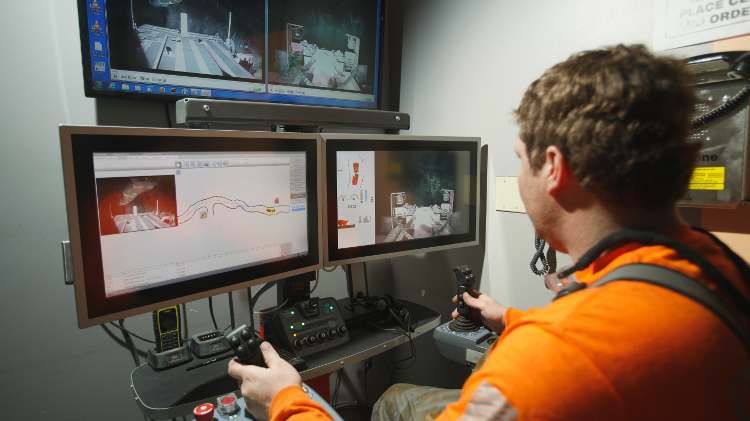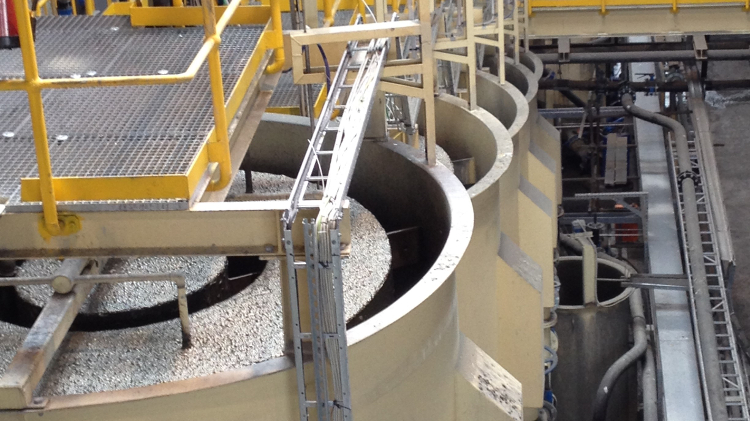Motion Metrics’ PortaMetrics fragmentation analysis tablet uses multiple cameras and stereo imaging to analyze post-blast rubble. Courtesy of Capstone Mining
Capstone Mining’s Pinto Valley copper mine in Arizona improved its crusher throughput after buying a handheld fragmentation analysis tablet designed by Motion Metrics International Corp. The device provides quick post-blast reports that help optimize the next round of drill patterns.
The PortaMetrics system is a rugged tablet outfitted with three cameras and software for interpreting photographs. “We’re using stereo imaging, which is a pretty well-established technology in robotics research,” said Nicholas Himmelman, technical sales manager at Motion Metrics. Two of the cameras photograph the same rock to provide depth perception, using the slight difference in apparent position between objects seen from slightly different angles. That yields a precise distance from the camera to each rock, which the software can then use to calculate the size of the rock based on the number of pixels it takes up in the photo.
The tablet’s three cameras provide flexibility. At a very short range, it is necessary to use two cameras that are close together. More than five metres away, it is better if the cameras are farther apart.
PortaMetrics was the first fragmentation analysis solution Pinto Valley invested in after restarting in 2012. In the first few years of operation, the mine had other priorities. But Nathalie Légaré, drill and blast specialist at Pinto Valley, had begun to hear critiques from the milling department. “It started to become a focus for us,” she said, “because our crusher [superintendent] was saying, ‘Hey, you are sending some large rocks,’ and ‘Maybe we can increase our throughput if the fragmentation is a little bit finer.’”
Motion Metrics already provided monitoring solutions for Pinto Valley’s shovels and loaders. “We were looking into a little machine like this and Motion Metrics came and made a presentation, and we fell in love with it,” said Légaré.
Légaré had previously used a different solution on other mine sites, one that has a couple of significant downsides. First, it presents safety hazards. To estimate fragment size, it requires a reference object to be placed amid the rubble. That means someone needs to take an object of a known diameter like a basketball, ask the excavator operator to stop, and climb up to the bench face to position the ball. This inherently risky practice is mitigated by bringing along a spotter. With PortaMetrics, Légaré or one of the surveyors she has trained can go on a solo drive and snap photos when the working shovel offers a clear line of vision, from metres away.
The second disadvantage of the preceding technology is that it requires the user to extensively mark up each image manually. PortaMetrics, on the other hand, can provide preliminary results on the spot. “We really like using their product because it’s easy to use and it gives you quick answers,” said Légaré. “You don’t have to spend hours in front of the computer doing image treatment.”
For precise accuracy, she still has to do some treatment of the snapshot data; for example, shadows might fall on a few rocks so that they look like one boulder, in which case someone would then have to manipulate the image to define them as separate. But that is a relatively minor time commitment.
According to Himmelman and Légaré, PortaMetrics provides about the same level of accuracy as other fragment analysers, just faster and more safely. However, in certain situations, with a large angle between the camera and the face or if the surface being photographed is irregular, the PortaMetrics can offer better accuracy, said Himmelman. At a distance of 10 metres, the smallest rock it can measure is three centimetres wide.
Better blasting
Légaré primarily uses PortaMetrics to verify that her drill patterns are meeting the crushing superintendent’s request for p80 six inches (80 per cent of the fragments six inches or less). She gets at least one picture per blast, aiming for the middle of the heap after the first few rows have been cleared. When trying out a new drill pattern, she takes two or three images in the same blast to see if the fragmentation is consistent.
“[PortaMetrics] gives you a neat little report that shows you the size fragmentation distribution graph,” said Légaré. “It will show you your p80, or your p10, and it will tell you your maximum oversize and your minimum oversize. So you give those to your crushing people, who are just totally loving it.” Having the data also provides an objective way to agree on the quality of mill feed.
Users define the parameters they want to see in their reports. In addition to size distribution, the analyser can calculate the slope of the ore heap, which can be useful in ensuring it is neither too steep for stability nor too shallow for shoveling efficiency.
Légaré said the $35,000 device has paid for itself. “More material can pass freely through the primary crusher and go straight to the secondary, where they can do their jobs and have less material to crush, so to speak,” she said. “So we can increase our throughput. It’s also a lot of electricity for the metal to chew on a boulder that is five feet. So it helps to save on energy – and wear and tear as well, because a boulder that stays in your metal forever is going to wear more than if the material is like sand and just passes through.” After purchasing the analyser in May 2015, Pinto Valley increased throughput to about 56,000 tonnes per day (tpd) in the second quarter of this year up from about 48,000 tpd the same time the year before.
Légaré added that the finer material also improved productivity prior to milling. “Our loading times improved,” she said. “The loading units have fewer big chunks to take in their buckets, so our fill factor is improved as well. And it’s probably smoother for the haul truck driver as well to be loaded with sand.”
Advanced features
Pinto Valley is one of more than 50 sites that have taken up PortaMetrics in the two years since its introduction to the market, according to Himmelman. Unlike Motion Metrics’ other solutions, this device has attracted blasting service providers and consultants as well as mine operators. Some of them use multiple devices on multiple sites, but push the data to one server for comparison’s sake. The interface includes user-defined tagging and GPS location so that users can sort and search their data quickly.
Himmelman said his company would like to see its solutions tied together at the large mines that use more than one product; for example, if the material that PortaMetrics photographs is too coarse, that would explain why ShovelMetrics is showing the excavator digging slowly. MetricsManager, the server-based desktop application that comes with the solutions, would be the nexus for this kind of activity.
“The things we’re really working on now are trying to make the MetricsManager a better environment,” he said. At the moment, editing and analysis must be done directly on the tablet, and the results are mirrored on the server. The updated version scheduled for release at Minexpo in September will allow someone working from the server to see the photographs and edit them there. “So essentially, if you took a picture in a pit, right away you’d be able to do all of the same modifications, editing and analysis on the server.”




